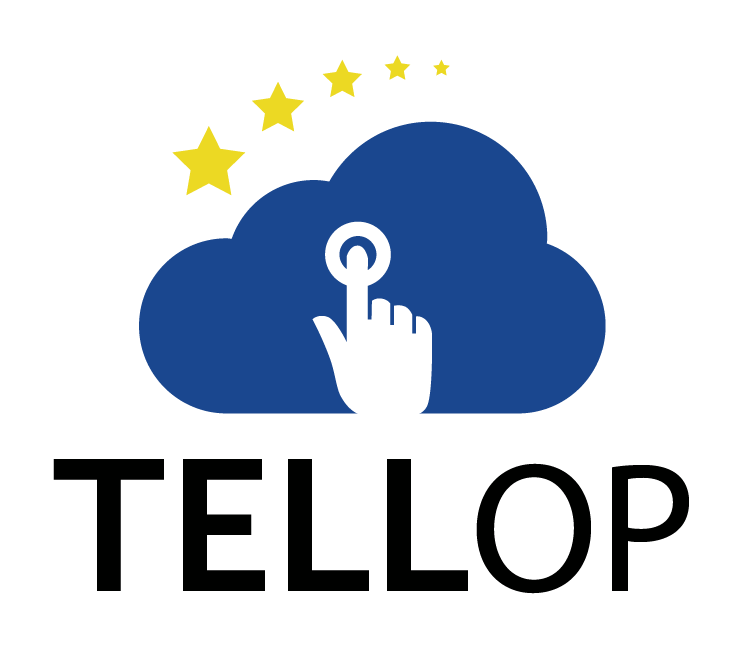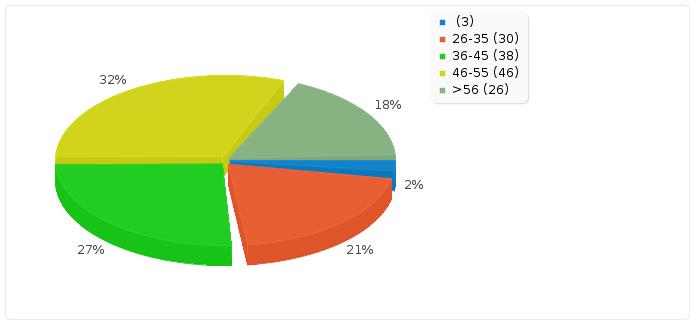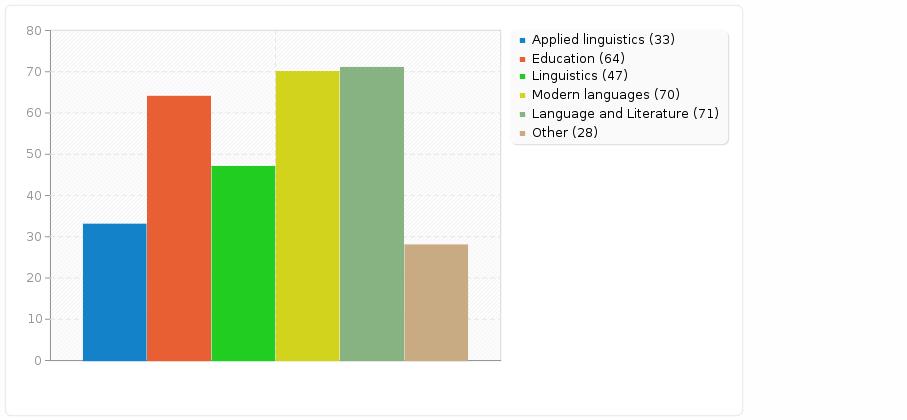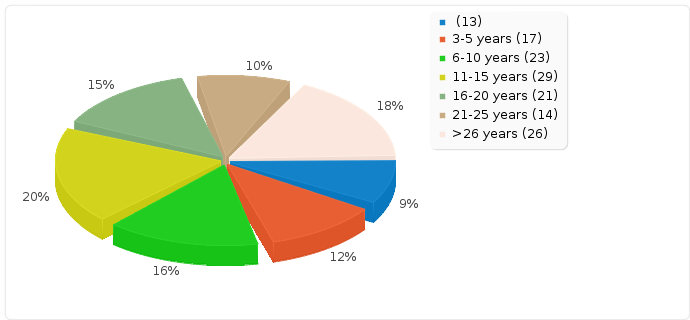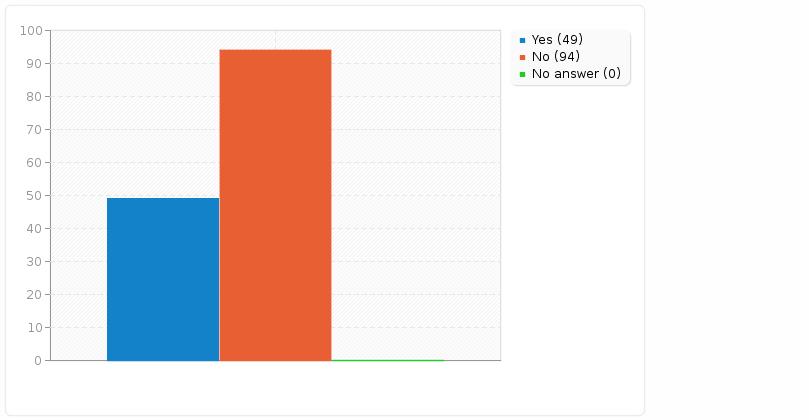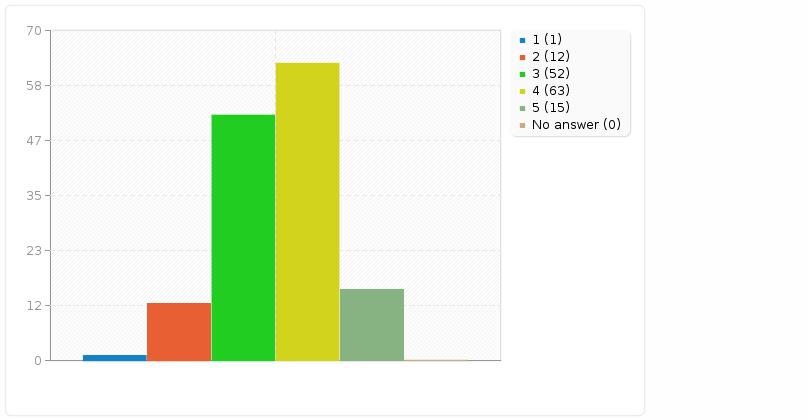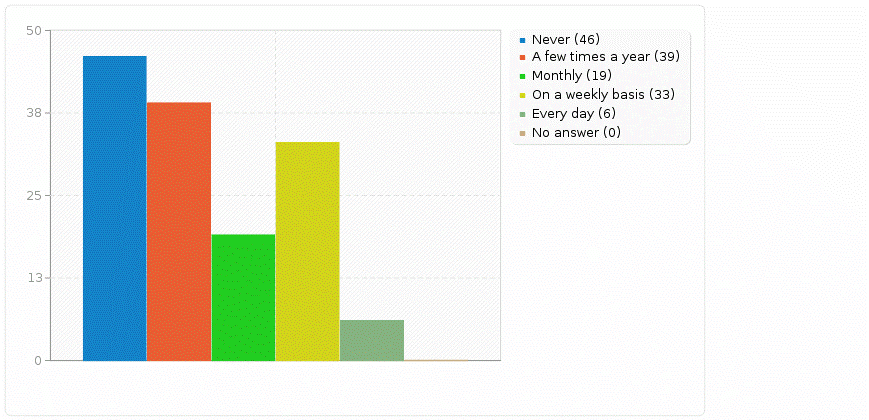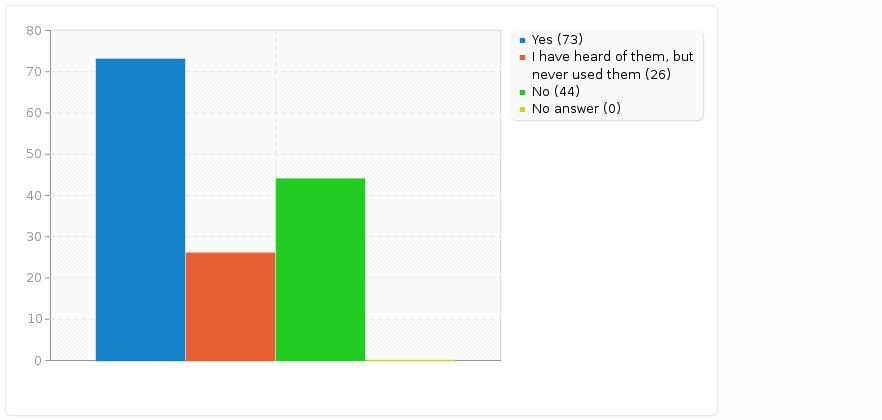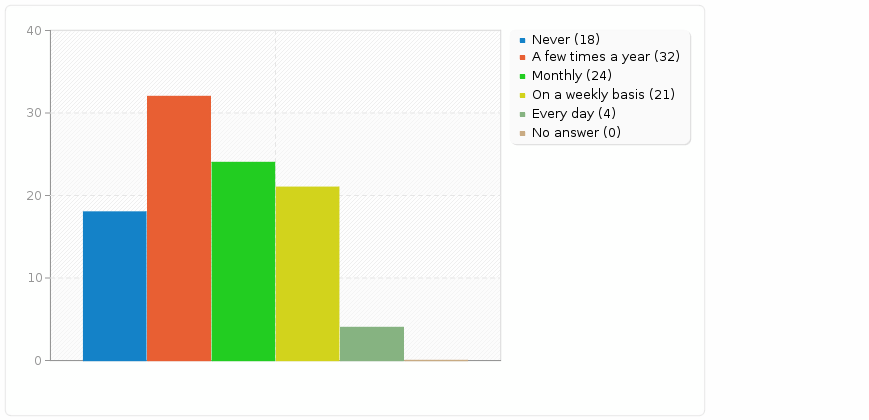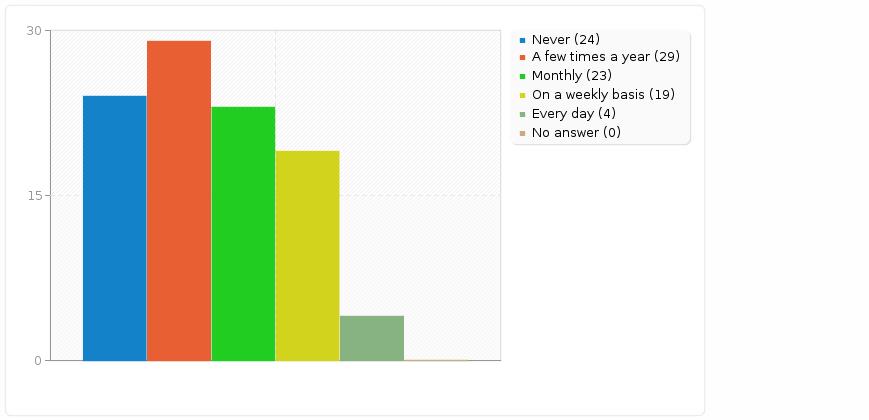Please quote this publication as follows:
Götz, S. and Puga, K. 2015. A survey of existing OER resources in the field of language processing and their uptake: Germany. URL: http://www.tellop.eu/survey-report-germany/
Altogether, there are 143 responses to the survey from Germany, which amounts to 20.72% of all responses. The following sections summarize the findings.
1. Participant Profiles
Results from Block A show that participants from Germany were also predominantly women (71.33%); the age groups of the German participants are summarized in Figure 1. The age groups are quite evenly distributed, with the group of 26-35 representing 20.98%, the group between 36-45 26.57%, the group between 46-55 32.17%, the group <56 representing 18.18%. Only the young age group under 26 is only represented by 2.10%. Comparing the non-familiarity with OERs, we found that 25 (56.82%) female and 18 (43.18%) male respondents were not familiar with OERs. The age group that was the most familiar with OERs, ranges from 46 to 55 (36.99%) years, which is quite surprising given the correlation between computer literacy and age of the higher age groups.
Figure 1 – Age group of the German participants
The field that best describes the participants’ level of education is an MA (48.25%), followed by a PhD (16.78%) and by a BA (14.69%). 20.28% specified “other” qualifications, such as a state examination (the usual education level for teachers in Germany). The participant’s most frequent training background is illustrated in Figure 2:
Figure 2 – Previous training Background of the participants
Most of the participants have an educational background in Language and Literature (49.65%) and/or Modern Languages (48.95%), followed by Education (44.76%), Linguistics (32.87%), Applied linguistics (23.08%) and “Other” backgrounds (19.58%) (more than one answer was possible here). The years of experience the participants have had are shown in Figure 3.
Figure 3 – years of experience in teaching of the participants
Very much in line with the findings for the participants’ age groups, most participants of the survey are rather experienced in language teaching. The most frequent group had between 11-15 years of experience (20.28%), followed by the group that even had more than 26 years (18.18%), 6-10 years (16.08%), 16-20 years (14.69%), 3-5 years (11.89%), 21-25 years (9.79%) and less than 3 years (9.09%).
The vast majority of the surveyed people work in an adult education institution (46.85%)or a higher education institution (41.96%), followed by teachers working in Secondary (13.29%) school or a Vocational Training Institution (9.09%) or a Primary school (1.40%). 14.69% indicated to work in “other” institutions.The distribution of foreign and/or second languages these teachers teach in their institutions is summarized in Table 1.
| Language | N | % |
| English as FL (1) | 63 | 44.06% |
| English as SL (2) | 8 | 5.59% |
| French as FL (3) | 4 | 2.80% |
| French as SL (4) | 0 | 0.00% |
| German as FL (5) | 23 | 16.08% |
| German as SL (6) | 9 | 6.29% |
| Spanish as FL (7) | 22 | 15.38% |
| Spanish as SL (8) | 2 | 1.40% |
| Turkish as FL (9) | 1 | 0.70% |
| Turkish as SL (10) | 0 | 0.00% |
| Other | 11 | 7.69% |
| Total | 143 | 100% |
Table 1: Languages taught by German participants
English as a foreign language is the subject most of the participants teach (44.06%), followed by German as foreign language (16.08%) or Spanish as a foreign language (15.38%).
2. Technology and Mobile Devices
In Germany, the proportion of students who have access to WiFi in their institutions is a little bit higher (58.74%) than the ones who do not haveaccess (41.26%). When looking at the German institutions that foster the use of mobile devices in the teaching context, most of the German institutions do not foster their use (65.73%), see Figure 4.
Figure 4 – the number of German participants whose institution fosters the use of mobile devices in the teaching context
These findings are also reflected in the next question, namely whether the participants received any training in the use of mobile devices from their respective institutions. The findings of the survey show that the overwhelming majority has not received any instruction (81.12%) in using mobile devices in their teaching. The very few (27 participants) who have enjoyed training in the use of mobile devices in their teaching, were mainly from higher (48.15%) and adult education institutions (48.15%). According to their personal computer skills, (1 being no knowledge about computers and 5 being perfect computer skills), the majority of the participants rated themselves either 3 (36.36%) or 4 (44.06%) or even 5 (10.49%). This is also illustrated in Figure 5.
Figure 5 – The German participants’ computer skills (1 being no knowledge about computers and 5 being perfect computer skills)
The next question asked which devices the participants use in the teaching context. The majority of the German survey participants do use a variety of devices in their classrooms, as shown in Table 2. Most frequently, the Germans use teaching/ learning online platforms (47.55%), indeed followed by smartphones (38.46%), web services (37.06%) and the schools’ computer labs (34.27%). 14.69% of the German teachers answered that they do not use any of these devices in the classroom. Interestingly, many teachers indicated that they often use their own tablets or smartphones in the classroom.
| Device used for teaching in the German classrooms | N | % |
| Tablets (1) | 27 | 18.88% |
| Smartphones (2) | 55 | 38.46% |
| Web services (3) | 53 | 37.06% |
| Teaching/ Learning online platforms (4) | 68 | 47.55% |
| Computer Lab at school (5) | 49 | 34.27% |
| None (6) | 21 | 14.69% |
| Other | 25 | 17.48% |
Table 2 – The German teachers’ use of computer devices for language teaching (more than one answer was possible)
When the German teachers were asked about the frequency with which they use mobile devices in their language teaching, 32.17% said “never”, followed closely by “a few times a year” (27.27%).13.29% use them monthly, 23.08% on a weekly basis and 4.20% every day. See Figure 6 for the exact breakdown of the German participants.
Figure 6 – The German participants’ frequency of use of mobile devices in language teaching
Finally, the teachers were asked how often they think their students use mobile devices for their language learning. The results show that most of the subjects answered “on a weekly basis” (39.86%), “every day” (26.57%), only “a few times a year” (14.69%) or even “never” (11.19%).
3. Open Educational Resources (OERs)
The first question in question block C is concerned with the question whether the participants are familiar with OERs. As Figure 7 shows, most of the teachers are indeed familiar with OERs (51.05%), while about one third is not (30.77%) and 18.18% have heard of OERs, but have not used them yet.The follow-up question, whether the participants would like to know more about OERs was answered in the affirmative by the great majority (76.92%); 1.40% do not want to know more about OERs and 21.68% did not answer this (not mandatory) question.
Figure 7 – The German teachers’ familiarity with Open Education Resources
The remaining survey questions were only asked, if participants had indicated they know about OERs, which reduced the number of participants to 71 for the remainder of the survey. These participants were now asked how often they actually use OERs. The findings suggest that most of the teachers use them (themselves) “a few times a year” (32.32%), but some teachers use them much more often, e.g. 24.24% use OERs on a monthly basis, 21.21% on a weekly basis, 4.04% use them every day, and 18.18% never make use of OERs. The exact numbers are illustrated in Figure 8.
Figure 8 – The German participants’ frequency of use of OERs
The next question investigated the frequency of use of OERs in the context of language teaching, as illustrated in Figure 9. The results are quite similar to the previous question, with about one third of the German survey participants using OERs a few times a year (29.29%), monthly (23.23%), on a weekly basis (19.19%) or even every day (4.04%). 24.24% never use them in the context of language teaching.
Figure 9 – The German participants’ frequency of use of OERs for language teaching
The next questions zoomed in more closely on the teachers’ acquaintance with and personal use of particular technologies.The exact breakdown of these findings is summarized in Tables 3-5.
| Language Learning apps | Online Dictionaries | Online collocation dictionaries or databases | Text-to-speech techno-logies | Text summari-sation | Wordnet | |||||||
| Answer | N | % | N | % | N | % | N | % | N | % | N | % |
| Never heard of | 15 | 15.15 | 0 | 0.00 | 36 | 36.36 | 51 | 51.52 | 61 | 61.62 | 64 | 64.65 |
| I have heard of it but never used it | 52 |
52.53 |
3 | 3.03 | 27 | 27.27 | 40 | 40.40 | 31 | 31.31 | 23 | 23.23 |
| I some-times use it | 22 | 22.22 | 16 | 16.16 | 17 | 17.17 | 5 | 5.05 | 6 | 6.06 | 9 | 9.09 |
| I use it frequently | 9 | 9.09 | 50 | 50.51 | 16 | 16.16 | 3 | 3.03 | 1 | 1.01 | 2 | 2.02 |
| I always use it | 1 | 1.01 | 30 | 30.30 | 3 | 3.03 | 0 | 0.00 | 0 | 0.00 | 1 | 1.01 |
| No answer | 0 | 0.00 | 0 | 0.00 | 0 | 0.00 | 0 | 0.00 | 0 | 0.00 | 0 | 0.00 |
| total | 99 | 100 | 99 | 100 | 99 | 100 | 99 | 100 | 99 | 100 | 99 | 100 |
Table 3 – The German participants’ acquaintance with particular OERs for language teaching I
| Visual representation of word clusters | Automated word lists and frequency counts | Lemma-tisers | Automated Part of speech tagging | Vocabulary profiling | Spell checkers | |||||||
| Answer | N | % | N | % | N | % | N | % | N | % | N | % |
| Never heard of | 49 | 49.49 | 54 | 54.55 | 71 | 71.72 | 71 | 71.72 | 68 | 68.69 | 26 | 26.26 |
| I have heard of it but never used it | 31 | 31.31 | 28 | 28.28 | 24 | 24.24 | 18 | 18.18 | 17 | 17.17 | 23 | 23.23 |
| I some-times use it | 13 | 13.13 | 10 | 10.10 | 3 | 3.03 | 9 | 9.09 | 9 | 9.09 | 25 | 25.25 |
| I use it frequently | 6 | 6.06 | 4 | 4.04 | 1 | 1.01 | 0 | 0.00 | 3 | 3.03 | 13 | 13.13 |
| I always use it | 0 | 0.00 | 3 | 3.03 | 0 | 0.00 | 1 | 1.01 | 2 | 2.02 | 12 | 12.12 |
| No answer | 0 | 0.00 | 0 | 0.00 | 0 | 0.00 | 0 | 0.00 | 0 | 0.00 | 0 | 0.00 |
| total | 99 | 100 | 99 | 100 | 99 | 100 | 99 | 100 | 99 | 100 | 99 | 100 |
Table 4 -The German participants’ acquaintance with particular OERs for language teaching II
| Text density/readability index (e.g. Textanalyser, etc.) | L1 corpora (e.g. British National Corpus, COCA, etc.) | Specialised corpora/ lexical databases for University students | Learner corpora (LINDSEI, ICLE, etc. or your own) | Online corpus management tools | Other | |||||||
| Answer | N | % | N | % | N | % | N | % | N | % | N | % |
| Never heard of | 71 | 71.72 | 50 | 50.51 | 44 | 44.44 | 56 | 56.57 | 64 | 64.65 | 70 | 70.71 |
| I have heard of it but never used it | 24 | 24.24 | 22 | 22.22 | 27 | 27.27 | 29 | 29.29 | 24 | 24.24 | 6 | 6.06 |
| I some-times use it | 4 | 4.04 | 15 | 15.15 | 22 | 22.22 | 7 | 7.07 | 8 | 8.08 | 11 | 11.11 |
| I use it frequently | 0 | 0.00 | 7 | 7.07 | 3 | 3.03 | 5 | 5.05 | 2 | 2.02 | 6 | 6.06 |
| I always use it | 0 | 0.00 | 5 | 5.05 | 3 | 3.03 | 2 | 2.02 | 1 | 1.01 | 6 | 6.06 |
| No answer | 0 | 0.00 | 0 | 0.00 | 0 | 0.00 | 0 | 0.00 | 0 | 0.00 | 0 | 0.00 |
| total | 99 | 100 | 99 | 100 | 99 | 100 | 99 | 100 | 99 | 100 | 99 | 100 |
Table 5 – The German participants’ acquaintance with particular OERs for language teaching III
The survey results reflect a lot of diversity in the answers depending on the technology that was asked for in the survey. While, for example, well-known devices such as online dictionaries and spell checkers are used with great frequency by the German survey participants, other, more specialized devices, such as Text Density/Readability Index, Automated Part-of-Speech taggers or online corpus management tools are not familiar to the participants and the great majority of teachers had never heard of them. Additionally, the participants could mention other OERs they know of and/or use at the end of this question block. Here, they mentioned for example ActivBoard learning software, Hot Potatoes to conduct gap-filling exercises, Linguee, a parallel concordancer, and other websites that provide useful language learning tools or tasks.
In the last block of questions, the participants were asked whether they make use either of these OERs in their language teaching and if so, how often. The exact breakdown of these findings is summarized in Tables 6-8.
| Language Learning apps | Online Dictionaries | Online collocation dictionaries or databases | Text-to-speech techno-logies | Text summari-sation | Wordnet | |||||||
| Answer | N | % | N | % | N | % | N | % | N | % | N | % |
| Never | 64 | 64.65 | 17 | 17.17 | 72 | 72.73 | 91 | 91.92 | 93 | 93.94 | 85 | 85.86 |
| A few times a year | 20 | 20.20 | 20 | 20.20 | 15 | 15.15 | 6 | 6.06 | 4 | 4.04 | 11 | 11.11 |
| Monthly | 8 | 8.08 | 15 | 15.15 | 7 | 7.07 | 1 | 1.01 | 1 | 1.01 | 3 | 3.03 |
| On a weekly basis | 7 | 7.07 | 28 | 28.28 | 3 | 3.03 | 1 | 1.01 | 1 | 1.01 | 0 | 0.00 |
| Every day | 0 | 0.00 | 19 | 19.19 | 2 | 2.02 | 0 | 0.00 | 0 | 0.00 | 0 | 0.00 |
| No answer | 0 | 0.00 | 0 | 0.00 | 0 | 0.00 | 0 | 0.00 | 0 | 0.00 | 0 | 0.00 |
| total | 99 | 100 | 99 | 100 | 99 | 100 | 99 | 100 | 99 | 100 | 99 | 100 |
Table 6 – The German participants’ use of particular OERsin their language teaching I
| Visual representation of word clusters | Automated word lists and frequency counts | Lemma-tisers | Automated Part of speech tagging | Vocabulary profiling | Spell checkers | |||||||
| Answer | N | % | N | % | N | % | N | % | N | % | N | % |
| Never | 83 | 83.84 | 85 | 85.86 | 94 | 94.95 | 90 | 90.91 | 85 | 85.86 | 70 | 70.71 |
| A few times a year | 8 | 8.08 | 7 | 7.07 | 3 | 3.03 | 7 | 7.07 | 9 | 9.09 | 9 | 9.09 |
| Monthly | 7 | 7.07 | 5 | 5.05 | 2 | 2.02 | 2 | 2.02 | 2 | 2.02 | 10 | 10.10 |
| On a weekly basis | 1 | 1.01 | 2 | 2.02 | 0 | 0.00 | 0 | 0.00 | 3 | 3.03 | 4 | 4.04 |
| Every day | 0 | 0.00 | 0 | 0.00 | 0 | 0.00 | 0 | 0.00 | 0 | 0.00 | 6 | 6.06 |
| No answer | 0 | 0.00 | 0 | 0.00 | 0 | 0.00 | 0 | 0.00 | 0 | 0.00 | 0 | 0.00 |
| total | 99 | 100 | 99 | 100 | 99 | 100 | 99 | 100 | 99 | 100 | 99 | 100 |
Table 7 – The German participants’ use of particular OERs in their language teaching II
| Text density/readability index | L1 corpora | Specialised corpora/ lexical databases for University students | Learner corpora | Online corpus management tools | Other | |||||||
| Answer | N | % | N | % | N | % | N | % | N | % | N | % |
| Never | 94 | 94.95 | 79 | 79.80 | 78 | 78.79 | 87 | 87.88 | 93 | 93.94 | 76 | 76.77 |
| A few times a year | 4 | 4.04 | 6 | 6.06 | 10 | 10.10 | 6 | 6.06 | 3 | 3.03 | 6 | 6.06 |
| Monthly | 1 | 1.01 | 9 | 9.09 | 7 | 7.07 | 3 | 3.03 | 2 | 2.02 | 8 | 8.08 |
| On a weekly basis | 0 | 0.00 | 4 | 4.04 | 3 | 3.03 | 2 | 2.02 | 0 | 0.00 | 4 | 4.04 |
| Every day | 0 | 0.00 | 1 | 1.01 | 1 | 1.01 | 1 | 1.01 | 1 | 1.01 | 5 | 5.05 |
| No answer | 0 | 0.00 | 0 | 0.00 | 0 | 0.00 | 0 | 0.00 | 0 | 0.00 | 0 | 0.00 |
| total | 99 | 100 | 99 | 100 | 99 | 100 | 99 | 100 | 99 | 100 | 99 | 100 |
Table 8 – The German participants’ use of particular OERsin their language teaching III
At the end of the survey, there was an open-ended question asking the participants about their expectations from an OER application that makes use of language-processing technologies. 65 out of 143 participants answered this optional question. With a content analysis approach we categorized their expectations as follows:
- App Use-related expectations:
- clear and simple instructions
- user friendly, intuitive
- customized for adults
- attractive design
- training manuals/videos for teachers and students
- text-to-speech and speech-to-text technologies
- integration of platforms/devices for communication and exchange of materials, chatroom applications, communication tools (e.g. Whatsapp)
- collocational profiles
- videos, audios, and visualizations
- translation options (e.g. thesaurus)
- possibility to dismiss certain OERs temporarily
- sharing of personal vocabulary lists
- Language-related expectations:
- comprehensible authentic use of language (real-life examples and language use)
- parallel corpus options, specialized corpora
- language varieties options
- L1 comparisons (students mother tongue)
- contextualisation , language in interaction
- literature
- Learning-related expectations:
- communicative activities
- skill-based approach
- vocabulary (with sound, according to topics), pronunciation/phonetics (with sound) and grammar practice
- activities with instant feedback, spell checker
- inclusion of mnemonic techniques
- learner progress report (for students)
- Webquests
4. Conclusion
Looking at the data obtained, we can see that the majority of the German teachers do not use OERs regularly in their language teaching. Apart from online dictionaries, the teacher indicated that they ‘never’ use them in 64%-95% of the OERs that were asked for in the survey. Mobile learning apps are used somewhat more frequently, with 35% of the teachers using them a few times a year, monthly or even weekly. The other devices, however, are essentially not existent in the language learning classrooms in Germany. However, this does not come as too much of a surprise, given the low numbers for being acquainted with the above mentioned devices in the first place.
